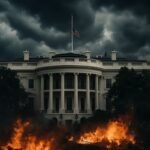A Shield in the Sky or a Cold War Revival?
Laser beams fired from satellites. Orbital sentinels scanning the skies. Missile batteries on constant alert.
This is not science fiction—it’s Donald Trump’s Golden Dome, a proposed space-based missile defense shield that could cost up to $175 billion.
Supporters call it a revolutionary step for U.S. security. Critics see a colossal money sink, technically shaky and strategically dangerous. One thing is clear: the Golden Dome is set to redefine the global defense race—possibly sparking a new Cold War in orbit.
The Dream of Star Wars 2.0
Trump’s announcement echoes Ronald Reagan’s “Star Wars” initiative of the 1980s: a futuristic umbrella designed to intercept Soviet missiles before they reached American soil. That project collapsed under technical and financial weight.
But Trump insists his Golden Dome will succeed where Reagan failed.
“We will have the best system ever built,” he declared at Al Udeid Air Base in Qatar, before repeating the promise at the White House and NATO summit in The Hague.
The shield is also inspired by Israel’s Iron Dome, famous for intercepting rockets from Gaza and Iran. Yet experts warn the scale is radically different. Jeffrey Lewis of the Middlebury Institute compared the two:
- Iron Dome: “a kayak.”
- Golden Dome: “a battleship.”
How the Golden Dome Would Work
The system is designed to neutralize threats across four phases of an attack:
- Early detection – Satellites spot missile launches almost instantly.
- Boost-phase interception – Space-based lasers or interceptors attempt to destroy missiles seconds after launch.
- Mid-course defense – Additional satellites track and strike during mid-flight.
- Terminal defense – Land and sea systems try to block surviving warheads as they descend.
In theory, this could handle ballistic, cruise, and hypersonic missiles—the latter considered nearly unstoppable today because of their speed and maneuverability.
A demonstration video by Lockheed Martin shows American cities shielded under a glowing dome of orbital defenses, almost like a sci-fi movie trailer.
Pentagon Warnings: “We’re Not Ready”
The Pentagon has been sounding alarms for years: China and Russia now field hundreds of ICBMs and thousands of cruise missiles capable of striking the U.S. mainland. Current ground-based defenses in Alaska and California fail nearly half their tests.
Analysts Chuck de Caro and John Warden, writing in Defense News, argue the Golden Dome is not yet sufficient to stop a Chinese strike, especially if triggered by a Taiwan conflict. The risk? The U.S. could be caught off guard, like in Korea in 1950.
The Big Players and the Big Money
For the American defense industry, the Golden Dome is the contract of the century.
- L3Harris Technologies is building sensor satellites in Indiana, pouring $150 million into new facilities.
- Lockheed Martin is promoting orbital shields with flashy simulations.
- RTX Corp is vying for hypersonic detection deals.
- Booz Allen Hamilton claims it could launch 2,000 satellites for $25 billion.
Trump has placed Gen. Michael A. Guetlein of the U.S. Space Force in charge. The goal: make the system operational by 2030, before the end of Trump’s second term.
But the numbers are staggering. Current funding: $25 billion. Estimated final cost: $175 billion, possibly more than $500 billion if stretched over 20 years, according to the Congressional Budget Office.
Musk, Bezos, and the Politics of Space
The project is not only a military gamble but also a political and business battlefield.
Elon Musk’s SpaceX, with its Starlink mega-constellation, was once Trump’s favored partner. Their fallout has pushed the White House toward alternatives like Amazon’s Project Kuiper, Rocket Lab, and Stoke Space.
Meanwhile, Palantir (Peter Thiel) and Anduril (Palmer Luckey) are lining up to contribute AI and autonomous systems.
Democratic lawmakers, led by Sen. Elizabeth Warren, are already demanding investigations into conflicts of interest—especially if Musk’s companies still secure contracts.
Military Skepticism and Technical Hurdles
Despite Trump’s promises of a 97% interception rate, doubts run deep:
- Boost-phase kills are extremely difficult. As one Lockheed executive admitted, hitting a missile seconds after launch is “terribly hard.”
- Lasers in space remain untested. Thomas Withington of RUSI notes they’re lighter and cheaper than missiles, but no country has ever fired them in orbit.
- Interceptor math doesn’t add up. The American Physical Society estimates it could take 16,000 interceptors to stop just 10 missiles like North Korea’s Hwasong-18.
Fabian Hoffmann of the Centre for European Policy Analysis bluntly called it a “money-eating monster.”
Geopolitical Risks: Toward a New Cold War?
China has already voiced concern. Russia hints at talks on tactical nukes if the project advances. Analysts fear a spiraling arms race in anti-satellite weapons, with each side trying to blind or destroy the other’s constellations.
Some believe Trump’s real goal mirrors Reagan’s Cold War strategy: force adversaries to overspend on defense, weakening their economies. But the risk is clear: if a future U.S. administration cancels the Golden Dome, tens of billions could vanish into a black hole of abandoned hardware.
Shield or Mirage?
The Golden Dome embodies Trump’s style—grand, gold-tinted, and controversial. It taps into American fears of vulnerability while promising near-magical protection.
Yet history warns us: missile shields have a habit of failing under pressure, draining treasuries, and destabilizing fragile global balances.
Whether the Golden Dome becomes America’s ultimate safety net—or its costliest illusion—remains to be seen.
What do you think? Is the Golden Dome a bold necessity or a high-priced fantasy?




